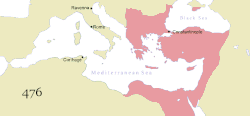
Back الإمبراطورية البيزنطية تحت حكم السلالة الجستينية Arabic Βυζαντινή Αυτοκρατορία υπό τη Δυναστεία του Ιουστινιανού Greek Imperio bizantino bajo la dinastía justiniana Spanish امپراتوری بیزانس تحت خاندان ژوستینین Persian Dynastie des Justiniens French Բյուզանդիան Հուստինիանոսների օրոք Armenian Kekaisaran Romawi Timur di bawah Dinasti Yustinianus ID Impero bizantino durante la dinastia giustinianea Italian 유스티니아누스 왕조 치하의 동로마 제국 Korean Византија под Јустинијановата династија Macedonian
Byzantine Empire
| |
|---|---|
| 518–602 | |
 The Byzantine Empire at its greatest extent since the fall of the Western Roman Empire, under Justinian I in 565 AD. | |
| Capital | Constantinople |
| Common languages | Greek, Latin |
| Government | Monarchy |
| Emperor | |
• 518–527 | Justin I |
• 527–565 | Justinian I |
• 565–574 | Justin II |
• 574–582 | Tiberius II |
• 582–602 | Maurice |
| History | |
• Accession of Justin I | 10 July 518 |
• Deposition of Maurice | 27 November 602 |
| Justinian dynasty | ||
|---|---|---|
| Chronology | ||
|
||
| Succession | ||
|
||
| History of the Byzantine Empire |
|---|
 |
| Preceding |
| Early period (330–717) |
| Middle period (717–1204) |
| Late period (1204–1453) |
| Timeline |
| By topic |
|
|
The Byzantine Empire underwent a golden age under the Justinian dynasty, beginning in 518 AD with the accession of Justin I. Under the Justinian dynasty, particularly the reign of Justinian I, the empire reached its greatest territorial extent since the fall of its Western counterpart, reincorporating North Africa, southern Illyria, southern Spain, and Italy into the empire. The Justinian dynasty ended in 602 with the deposition of Maurice and the ascension of his successor, Phocas.
